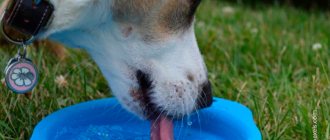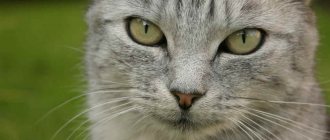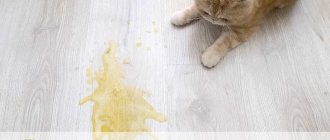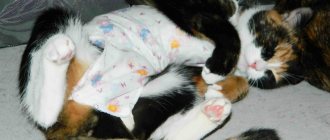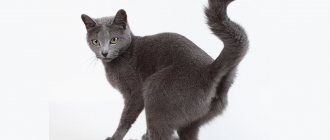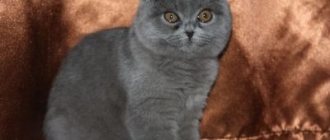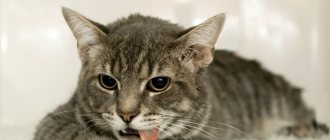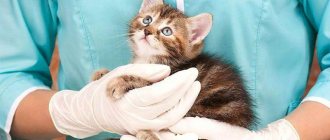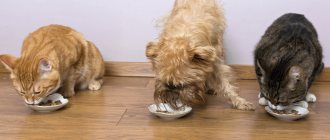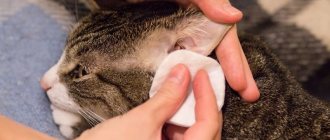Does your cat vomit after eating? Has your cat started vomiting often? What to give a cat for vomiting? What to feed your cat after vomiting ? In this article we will answer these and other questions and understand the reasons frequent vomiting in a cat and learn to take the necessary measures.
There is practically not a single animal owner in this world who has not at least once seen such a phenomenon as vomiting in their pet. Vomiting in a cat is a reflex process in which the contents of the stomach are expelled through the mouth, sometimes through the nose. Abdominal muscles contract, strong salivation, and involuntary swallowing movements occur. The act of vomiting in a cat is regulated by the vomiting center, which is located in the medulla oblongata.
Animal owners do not always pay due attention to what happened, very often believing that it is simply the body’s reaction to food. Indeed, vomiting in a cat can have a completely simple reason that does not require examination by a veterinarian. But the difficulty lies precisely in the fact that the causes of vomiting in a cat are so varied that determining the truth can become a very difficult and time-consuming task.
Types of vomiting in cats
Sporadic vomiting in a cat can occur with liver disease, kidney disease, diabetes mellitus, worms, chronic gastritis, and irritable bowel syndrome.
Persistent vomiting in cats occurs due to injuries, when the cat eats grass, hairballs or foreign objects, or infectious enteritis.
In the case where there is blood in the vomit, such vomiting usually occurs when a foreign object is swallowed, causing injury to the mucous membrane of the esophagus and stomach. If the owner of the cat detects blood in the vomit of the cat in the form of “coffee grounds,” this indicates bleeding in the stomach or in the upper parts of the small intestine. If there is an unpleasant foul odor from the vomit, it is necessary to exclude intestinal blockage or peritonitis. Sometimes such vomiting in a cat occurs as a result of blunt trauma to the abdomen.
What to do if your kitten vomits food?
If a kitten vomits food, first of all, you need to rule out helminthic infestation. If the kitten has never been treated for parasites or has been treated for a long time, it is necessary to carry out treatment! Tablets based on milbemycin oxime or drops on the withers with emodepside and praziquantel are good for kittens against worms. If the kitten vomits several times, becomes sad, lethargic, and refuses to eat, you must immediately contact a veterinary clinic, otherwise the kitten may die!
There are several types of vomit in cats.
Vomit with hairballs.
This type of vomiting in cats is considered to be a normal process from a physiological point of view, which occurs in cats 1-2 times a month. Cats in a similar way free their stomachs from the fibers of their fur that have fallen during the process of licking. Such hairballs that have entered the stomach can be removed from the cat's stomach with the cat's feces. Sometimes such lumps in a cat can cause obstruction of the gastrointestinal tract.
Vomiting of whole, almost undigested food.
This type of vomiting in a cat occurs 15-30 minutes after the cat has finished eating. This vomiting occurs in a cat when it has previously been hungry and the animal is forced to eat a large amount of food due to hunger. It happens when, after eating, a cat is forced to engage in active games, jumping, when the food eaten is not able to be absorbed.
Vomit mixed with bile.
Bile is normally located in the gallbladder of a cat and should not normally be contained in vomit from the stomach. The appearance of bile tells its owner about diseases of the gallbladder or liver. When a cat's vomiting is prolonged, then after the contents of the stomach are released, bile begins to be released when the cat vomits. Bile entering the stomach causes inflammation of the gastric mucosa.
Vomiting liquid or foam.
This type of vomiting is preceded by 4-8 reflex muscle contractions of the abdomen. At the same time, the cat tenses and experiences discomfort. When a cat vomits, it stops licking itself, tends to hide in a secluded place and does not pay any attention to others. Sometimes it happens that despite an intense urge to vomit, it is not observed. However, this causes pain in the cat. At the same time, the cat refuses the food and water offered to it, due to the fact that they cause it to constantly vomit, the cat constantly licks its lips.
Vomit mixed with blood.
Individual inclusions of scarlet color in the vomit indicate mechanical damage to the digestive organs. These injuries most often occur in cats when they swallow foreign objects with sharp edges (meat and fish bones).
A rich red color indicates damage to the lower parts of the digestive system. This vomit may be the result of bleeding in the stomach, where the blood reacts chemically with gastric juice. This kind of vomit in cats occurs due to gastritis, malignant neoplasms, and also sharp objects that have entered the stomach.
Green vomit.
Green vomit in a cat occurs with diseases of the liver, gall bladder or intestinal obstruction. With these diseases, there is a large secretion of bile or when the contents of the intestines are thrown into the stomach. Vomiting of green matter in a cat occurs as a result of the cat consuming fresh or dry grass.
The presence of feces in the vomit.
The appearance of feces in a cat’s vomit indicates an intestinal blockage, an injury to the abdominal area, or the presence of peritonitis.
Diagnostics
If a cat vomits after eating, a comprehensive diagnosis must be carried out to identify the cause of this condition so as not to miss systemic diseases. First of all, the doctor conducts an examination, carefully examines the oral cavity for foreign objects, and tries to look into the throat. Next, palpation is performed to identify painful areas. Next, blood tests and instrumental diagnostic methods (ultrasound and X-ray) are required.
Blood tests - clinical and biochemical - are performed to identify systemic diseases of the pet. A general blood test reveals the presence of an inflammatory process that requires antibiotics, and anemia, which can be a consequence of internal bleeding, blood parasitic disease, viral infection, chronic kidney disease, etc. Blood biochemistry determines kidney and liver diseases.
Ultrasound of the abdominal cavity can reveal structural changes in the wall of the stomach, intestines, as well as the presence of a foreign object. Ultrasound can also reveal inflammatory diseases of the pancreas, liver, gallbladder, as well as the presence of a neoplasm in the gastrointestinal tract. All these changes can cause vomiting.
X-rays are performed to exclude radiopaque foreign bodies in the stomach and intestines. In most cases, both an ultrasound and an x-ray of the abdominal cavity are recommended: the fact is that only radiopaque objects are visible on an x-ray, and ultrasound is not a reliable method for excluding the presence of foreign objects.
Vomiting of undigested food in a cat requires, first of all, an x-ray and ultrasound of the abdominal cavity to rule out the presence of a foreign object in the stomach or intestines.
Vomiting of white foam while the pet's appetite remains unchanged usually requires a trial of treatment, which consists of changing the diet or food. If the condition is serious and the pet refuses to eat, a thorough and complete diagnosis is needed (ultrasound, x-ray, blood tests to exclude systemic pathologies).
Vomiting of bile requires, first of all, blood tests and an ultrasound of the abdominal cavity to detect liver and gallbladder diseases.
Vomiting of blood requires an abdominal ultrasound to identify the causes of bleeding and, at a minimum, a general analysis to determine the degree of anemia and the need for a blood transfusion for the pet.
Hurry up, choose a box and find out what gift awaits you
Discount on pet insurance
Promo code copied to clipboard
What diagnostic measures are carried out in a veterinary clinic?
When a cat is admitted, the veterinarian conducts a full clinical examination. During which the general condition of the cat’s body, coat, is assessed, body temperature is measured, and auscultation of the respiratory organs and heart is performed. Palpation of the abdominal area determines the tone of the abdominal muscles and determines the presence of certain foreign formations. To correctly judge the cat’s health, specialists must conduct a general and biochemical blood test, a blood test for the presence of parasites, pathogens of infectious diseases, a general urinalysis, a stool test for helminths, an ultrasound of the abdominal organs, and an ECG.
How to recognize vomiting?
Vomiting is a complex mechanism that usually begins with a stage of nausea in which the cat appears restless, and is often accompanied by salivation, repeated swallowing, and assuming a comfortable position.
Vomiting itself involves strong contractions of the abdominal muscles, expelling fluid, foam, or food. The intense effort involved in this process can be distressing for your cat.
It is important to be able to differentiate vomiting from coughing. Cats may cough up some foam or foamy material, which they subsequently swallow. When coughing, cats typically squat on all four legs with their necks extended. Your veterinarian can help you differentiate coughing from vomiting with video.
First aid
To alleviate some of the general condition of your cat, you need to stop feeding it for a day; you can leave free access to water, but only if the water does not cause new vomiting.
In the case when the cat vomited once and the cat feels normal after that, then the owner is not required to carry out treatment.
If a cat vomits more than three times a day, as a result of which the cat becomes depressed and painful, then after visiting a veterinary clinic, the cat is put on a special diet and food is limited. To prevent dehydration, the cat is prescribed Regidron solution or saline solution. If the cat refuses water, Ringer's solution is injected subcutaneously.
Treatment of vomiting should be aimed at eliminating the underlying cause of the cat's vomiting.
If the gastrointestinal tract is blocked by wool, pieces of wool are removed with a special probe. A conservative method of removing hair is to give it food with a high fiber content or prescribe drugs that cause rapid evacuation of hair from the stomach - Malt paste. Surgery is performed to remove hairballs.
The cat is given phenothiazine, torecon, and passertin as an antiemetic. If a cat's vomiting is caused by poisoning, it is prescribed internally with activated carbon (1 tablet per 10 kg of body weight), smecta, enterosgel and other adsorbent substances. To speed up the elimination of poisons that have entered the body, diuretics are prescribed.
In a veterinary clinic, to relieve intoxication, the cat is prescribed droppers with a solution of glucose and ascorbic acid.
For infectious diseases, a course of antibiotics is administered.
When vomiting caused by worms, deworming is carried out first.
Vomiting, its causes and dangers
Vomiting is a complex protective process based on reflexes, with the help of which the cat’s body gets rid of dangerous and harmful substances. Vomiting is usually the main symptom of gastrointestinal problems.
Let us immediately note that an attack of vomiting, occurring once every 3-4 days, is the norm, especially in cats. However, there are still specific reasons. To understand them, you need to analyze the cat’s diet, and perhaps make it starve for a while. Most often, cats vomit from overeating - they simply eat too much and too quickly. This applies to both dry food and natural food, but dry pieces are very easy to regurgitate, especially if they are poorly chewed. Most often, those animals that regurgitate are those that live in conditions of competition for food and therefore absorb food quickly and greedily. By the way, some of them will not disdain to eat the food removed from the body again.
Animals that live together tend to eat quickly and chew their food poorly, so regurgitation is common for them.
If a domestic cat often regurgitates food as soon as it leaves its bowl, then it is overeating or this type of food is of poor quality. Economy-class food, such as Felix, Whiskas, Sheba and the like, have a poor composition and contain many harmful additives, so such food will clearly not benefit your pet.
It is advisable to purchase premium and super-premium food for your pet, and for chronic diseases - specialized lines of such food
Causes of vomiting in cats
The main causes of vomiting can be divided into two large groups: reflex irritation of the digestive organs and poisoning.
In the first case, foreign substances or excessive amounts of food irritate the organs of the digestive tract and cause a reflex reaction of rejection. The following reasons may lead to this:
- improper diet: too rich, not suitable for cats, poor consistency (sticky, rubbery food, with bones, etc.);
- ingestion of a large amount of hair when licking (especially in long-haired cats): hairballs cause mechanical irritation of the stomach and also interfere with the normal excretion of feces from the body, which also contributes to vomiting;
- parasites that mechanically irritate the liver and intestines;
- chronic diseases of the gastrointestinal tract;
- ingestion of foreign bodies - small toys, hair bands, threads, waste from a garbage can;
- seasickness - vomiting due to disturbances in the functioning of the vestibular apparatus.
In the second case, poisoning occurs with toxic substances that enter the blood, spread throughout the body, irritate the vomiting center in the brain and cause vomiting. Intoxication may have the following origins:
- waste products of intestinal parasites - kittens are especially sensitive to their effects;
- poor quality, expired food;
- chemicals: detergents, bleach, medications, indoor plants;
- infectious and inflammatory diseases leading to disorders of the gastrointestinal tract;
- chronic kidney diseases, causing general intoxication of the body;
- false pregnancy, which can occur in cats after estrus;
- brain damage: trauma, edema, increased intracranial pressure;
- stress, shock or psychological trauma.
Danger of vomiting
A dangerous consequence of vomiting is dehydration, which quickly occurs with persistent and prolonged vomiting. It is especially poorly tolerated by small kittens. An animal can quickly die from dehydration, so if vomiting does not stop, you should immediately take the animal to a doctor.
With persistent vomiting, even water is not retained in the cat’s body: as soon as the cat drinks, it starts vomiting again
It is also necessary to measure the cat’s temperature: in case of infectious and inflammatory diseases it increases, in case of poisoning and shock it decreases. In both cases, you need to go to the doctor or call him at home.
The temperature in cats is measured in the anus for 2-3 minutes, the norm is a temperature of 38 to 39 degrees
The vomit should not contain blood, mucus, have a strange color or a foul odor - in this case, you should also contact your veterinarian immediately.
Preventing vomiting in cats
Prevention of vomiting in cats should be based on feeding fresh, good-quality food or purchased commercially produced food. Avoid feeding your cat raw fish and meat. Your cat must be vaccinated against infectious diseases common in your region. In order to prevent helminthic diseases, it must be treated for worms twice a year. If you keep cats of long-haired breeds, it must be brushed regularly so that its gastrointestinal tract does not become clogged with hair. In order to monitor its health, the cat must be periodically shown to the clinic’s veterinarian.
Serious violations
- A common cause of indigestion is food poisoning of poor quality. The cat vomits all the time before and after eating, diarrhea appears, this speeds up the process of removing toxins from the body.
- Viruses and bacteria lead to the death of a pet. Therefore, a visit to the veterinarian is urgent.
- Food contaminated with chemicals or poisonous plants can cause indigestion. They are prepared for rats and mice, dangerous for pets.
If vomiting returns repeatedly, blood and mucus are noticed in the vomit, the cat vomits before and after eating, and becomes lethargic, what to do in this case. The answer is clear - you need to see a veterinarian and after finding out the reasons, drug treatment will be indicated.
Vomiting a kitten
Vomiting in a kitten up to 2 months is evidence of the development of pathologies of the digestive system or low quality milk. If a nursing cat does not eat well, takes medications, or is sick, this is reflected in the composition of the nutritional fluid, which makes the kitten sick.
A common problem in the postpartum period is mastitis in cats. With a purulent form of inflammation of the mammary glands, milk becomes dangerous for kittens. It causes intoxication, the kitten vomits, and can lead to death.
In felines under the age of 2 months, while they are on mother's milk, the cause of vomiting is roundworms (nematodes). Kittens become infected with helminths from their mother while still in the womb. Small pets infected with parasites lag behind in development and slowly gain weight.
When a kitten vomits, it loses a lot of fluid. The situation is dangerous due to dehydration and low blood glucose levels. You cannot take measures on your own.
The field is 2-3 months old and in vaccinated kittens, vomiting occurs for the same reasons as in adult animals.
Cat vomits during pregnancy
Vomiting is a normal physiological reaction during pregnancy. There are two reasons:
- pressure on the stomach from a swollen uterus;
- intoxication at certain stages of pregnancy.
Attention! In the last week of pregnancy, vomiting is a precursor to labor. .
Vomiting occurs after eating or in the morning. The problem occurs constantly and causes discomfort to the animal. Vomit often contains semi-digested, undigested pieces of food. There are also no pathological inclusions (blood, bile, mucus). Only a small amount of white or yellow foam is allowed.
Vomiting white foam
Most often, this phenomenon does not pose a danger to the animal. This is saliva with foamy protein contents from the walls of the stomach. The cat may not eat much, its stomach is often empty. The diet and regimen should be reviewed.
However, it is necessary to observe the pet for several days. In the absence of other accompanying signs, the animal does not require therapy.
Diet for vomiting
If an animal suffers from nausea, its diet must be reconsidered. It should be balanced and dietary. Introducing rice water, flax seed, and chamomile infusion into the diet helps a lot.
In modern veterinary nutrition, there is a line of special foods with gastro-effects. During the acute period, it is better to use wet ones, then you can gradually add dry mixtures.
Specialized food contains a balanced complex of micro- and macroelements, vitamins and essential substances (such as taurine) necessary for the normal functioning of the cat’s body.
We recommend GastroIntestinal wet food (Royal Canin line) with a dietary effect and Hepatic dry food, which improves liver regeneration.
To improve the cat's condition, the probiotic drink Viyo is added to the diet, which is available in separate forms for kittens and adults.
It should be remembered that the change of food should be gradual, with the addition of a new product to the usual diet. Otherwise, the course of the disease can be aggravated by food stress.
Diseases that cause vomiting
The most common diseases accompanied by convulsive urges in cats:
- Feline distemper or panleukopenia is a severe infectious disease, often fatal, especially in kittens and unvaccinated individuals.
- Intestinal enteritis caused by coronavirus. Symptomatic therapy is required, the prognosis is favorable.
- Infectious peritonitis is caused by a pathogenic strain of coronavirus. A serious disease from which the animal can rarely be saved.
- Cat flu or calcivirus is characterized by convulsive stomach attacks in the initial stage. Timely vaccination of kittens will help prevent the disease.
- Theriotoxicosis is an endocrine pathology characteristic of older individuals. The cat eats a lot, but at the same time loses a lot of weight due to profuse eruption from the stomach. Therapy is symptomatic.
- Hypocorticism is a fairly rare disease - insufficiency of the adrenal cortex, accompanied by frequent foamy eruptions. The cause is often constant stress.
Vomits when poisoned
Sometimes vomiting indicates poisoning. This is observed in cats walking outside, because pets love to eat grass. But they don’t always know what plants they are allowed to eat.
A cat that does not walk can be poisoned by indoor flowers. Dangerous species include:
- azaleas;
- asparagus;
- geranium;
- irises;
- indoor palms;
- crocuses;
- lilies;
- daffodils.
Poisoning is indicated not only by vomiting, but by a number of other symptoms:
- convulsions;
- fainting;
- nervous pathologies;
- diarrhea;
- tachycardia;
- heavy, shallow breathing;
- high blood pressure.
If these signs are present, you should immediately contact your veterinarian. If this is not possible, give the cat Enterosgel, activated carbon.
An outdoor cat can become poisoned by rat poison. This happens especially often in pets who spend the summer at the dacha. If you are not using poison, it is worth asking your neighbors. Perhaps one of them uses zoocide.
